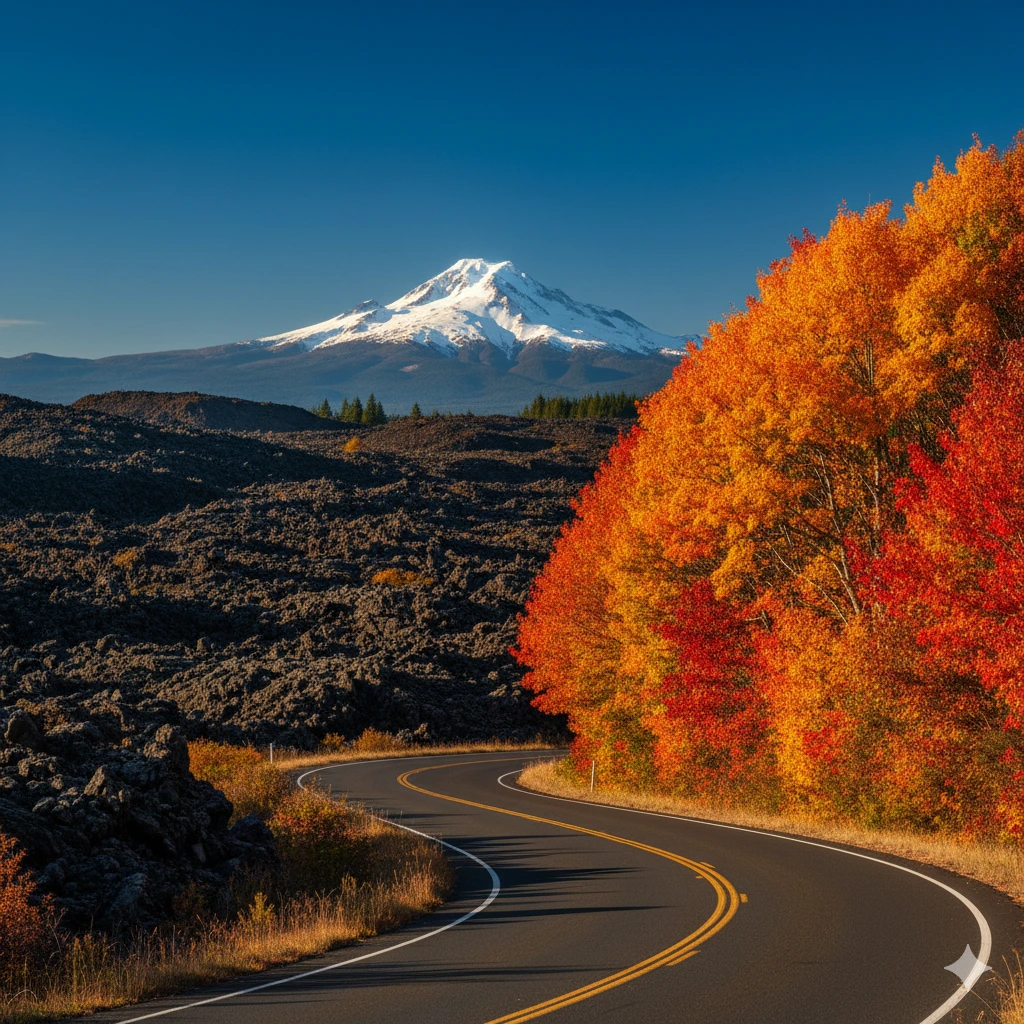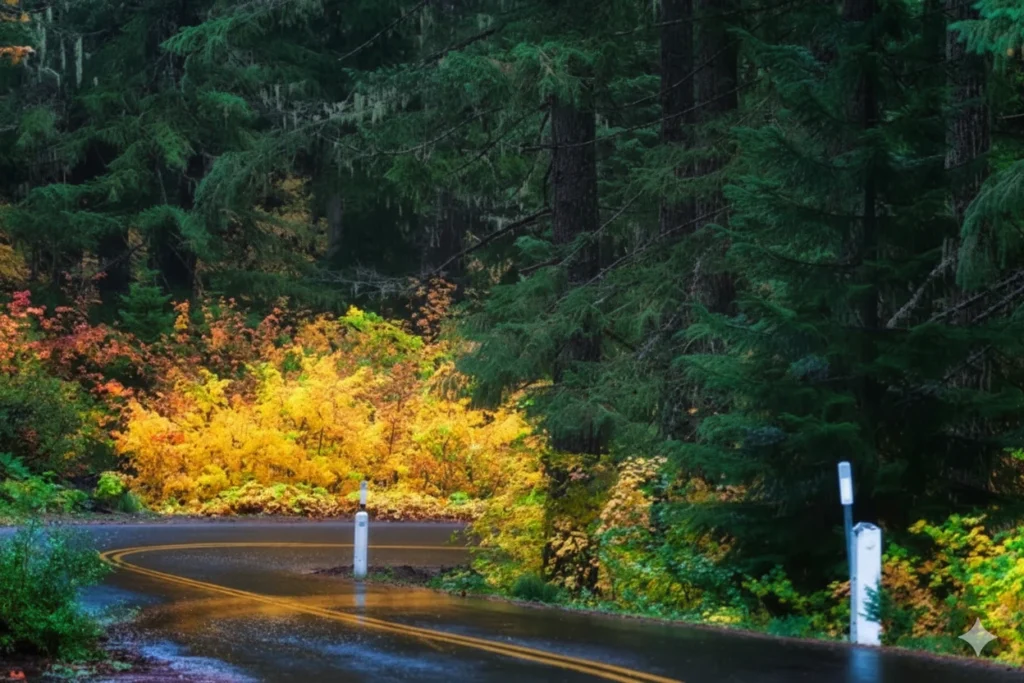
The Pacific Northwest fall colors are a spectacle best viewed from the open road. While many scenic routes claim the title of “best,” few can rival the sheer diversity and breathtaking beauty of the McKenzie Pass – Santiam Pass Scenic Byway in Central Oregon. This remarkable 82-mile loop offers an unparalleled journey through volcanic history, lush forests, dramatic waterfalls, and six towering peaks of the Cascade Mountains, culminating in one of the region’s most vibrant autumnal displays.
This comprehensive guide delves into the unique segments of the byway, providing the essential details and strategic stops needed to maximize your experience on this unforgettable Oregon scenic drive.
The Outset in Sisters and the Ascent to McKenzie Pass
The adventure begins in the charming, Western-themed town of Sisters. Known for its boutique shopping, vibrant art galleries, and as a gateway to diverse outdoor pursuits, Sisters sets a relaxed tone for the drive ahead.
As you depart on Oregon Highway 242, the landscape quickly transitions from the high desert to dense pine forests. This is where the first pockets of Pacific Northwest fall colors begin to emerge. Keep an eye out for the vibrant yellows and soft oranges of the cottonwoods and aspens interspersed among the dark green evergreens, creating a beautiful contrast that defines the high-elevation autumn experience.
Dee Wright Observatory: A Stop in the Lava Fields
The most striking feature of the first leg is the stark transition into the formidable McKenzie Pass lava fields. Here, the road winds through a rugged landscape of ancient, hardened black basalt, a silent testament to the region’s intense volcanic past.
A mandatory stop is the Dee Wright Observatory. Constructed in 1935 by the Civilian Conservation Corps (CCC) entirely from local lava rock, the observatory itself is a historical monument. More importantly, its viewing ports are strategically aligned to offer panoramic vistas of a half-dozen prominent Cascade peaks, including:
- The Three Sisters (North, Middle, and South Sister)
- Mount Washington
- Mount Jefferson
- Belknap Crater
On a clear day, the geological scope is awe-inspiring. Experts often note the McKenzie Pass area as one of the best locations in the lower 48 states to clearly observe this many major stratovolcanoes from a single vantage point, solidifying the drive as a geological tour.

The Aqueous Wonders of Willamette National Forest
Leaving the moonscape of the lava fields, the byway descends into the lush, temperate rainforest of the Willamette National Forest. This shift in ecosystem is dramatic and offers entirely new photographic opportunities.
Reflections at Scott Lake
One of the most serene and reflective stops—both literally and figuratively—is Scott Lake. Situated perfectly to capture the full grandeur of the Three Sisters peaks, the lake’s calm waters often provide a stunning, mirrored image of the mountains. This viewpoint is a favorite among landscape photographers and is a prime location to capture the vibrant forest greens against the bright blue of the sky and the white of early-season snow dusting the peaks.
Koosah and Sahalie Falls: The Waterfalls Segment
The route continues onto Oregon Highway 126, which leads directly to some of the area’s most popular waterfalls. The Koosah and Sahalie Falls Trail is a must-do loop, a relatively easy 2.6-mile path that immerses you in the powerful beauty of the McKenzie River.
- Sahalie Falls: The upper falls, a towering column of white water cascading 73 feet.
- Koosah Falls: The lower falls, where the river plunges 70 feet into a deep, jade-green pool.
The surrounding forest is dense with moisture-loving mosses and ferns. The intense humidity of this area often allows for incredibly rich and saturated colors from the deciduous trees in the fall, making the water features even more dramatic. ‘Hiking Gear Essentials for PNW Trails‘ provides excellent preparation for these stops.
The Northern Loop and The Return via Santiam Pass
The final segment of the loop leads the drive through the Santiam Pass area, a gateway to multiple winter recreation areas and pristine lakes. The byway passes Hoodoo Ski Area, signifying the high-elevation nature of the route.
Suttle Lake and the Autumnal Palette
For peak Pacific Northwest fall colors, the area around Suttle Lake is unparalleled. The lake’s shoreline is heavily lined with vine maples, a species famous for its intense, fiery autumn transformation. These maples turn shades of crimson, deep red, and bright orange, creating a spectacular, cohesive tapestry that frames the calm lake waters. This explosion of color provides a perfect counterpoint to the volcanic and high-mountain scenery seen earlier in the journey. The U.S. Forest Service often provides detailed updates on the status of this foliage, which is highly recommended for planning.
Planning Your Drive: Logistics and Timing
The entire 82-mile loop can technically be completed in under two hours without stopping. However, to truly appreciate the geological, ecological, and photographic opportunities, a planned duration of three to four hours is strongly recommended. This allows adequate time for:
- Exploring the Dee Wright Observatory and the lava fields.
- A brief hike to enjoy the Koosah and Sahalie Falls.
- Photo stops at Scott Lake and Suttle Lake.
Crucial Seasonal Note: The McKenzie Pass section of the byway (Oregon 242) is an important seasonal consideration. Due to its high elevation and frequent snow, this section typically closes in early November and remains inaccessible until late spring. This closure makes the weeks of late September and October—when the vibrant foliage provides a striking contrast with the snow-dusted peaks of the Cascade Mountains—the only perfect window to fully experience this breathtaking Oregon scenic drive.
The McKenzie Pass-Santiam Pass Scenic Byway is not merely a drive; it is a compact, world-class geological and ecological tour that perfectly captures the varied and magnificent spirit of the Pacific Northwest. Prepare your camera and your sense of adventure—you won’t be disappointed.